The scruffy exteriors of the buildings along the Rue de Belleville haven’t changed, but something is definitely stirring in this bawdy working-class neighborhood tucked into the northeasternmost corner of Paris. Creative types who could afford to live elsewhere are pouring into the dense village perched on a series of hills straddling the 19th and 20th arrondissements, and while low rents are part of the draw, there’s something more going on—an act of resistance, perhaps, to the centrifugal forces of money and real estate that have gentrified so many other “gritty” and proudly populaire neighborhoods. Belleville is a great escape from the elegant, orderly Paris created by Baron Haussmann. Local girl Édith Giovanna Gassion, a.k.a. Édith Piaf, who launched her career as the tantalizing incarnation of the neighborhood’s rough-and-tumble side, would be proud. (A commemorative plaque at 72 Rue de Belleville informs passersby that she was born there in 1915, though she actually saw the light of day in a nearby hospital.)
Whether the gradual arrival of artists will doom the earthy, multiethnic character of Belleville remains to be seen, but for now the influx merely adds another layer of skepticism to a neighborhood that’s always been fiercely independent. Previously a rustic outpost, Belleville boomed during the 1860s, as new housing was built for the thousands of workers needed for the proliferating factories, stores, and rail lines; the liberal character of this freshly minted proletarian neighborhood made it a notorious center of opposition to the rule of Emperor Napoleon III. Belleville was, in fact, the last quartier to surrender during the Paris Commune of 1871, and by 1900 it had become a teeming and rather louche area known for its music halls, cabarets, and pulsing street life. Belleville was a magnet for immigrants—by the 1930s, it already had large communities of Armenians, Greeks, and Polish Jews—but it was the tumultuous unraveling of France’s colonial empire in North Africa, in the early 1960s, that changed the area completely. “North African Jews moved to France because they feared reprisals in the newly independent Arab countries,” explained my Franco-Greek friend Athanos, who was born in Tunis but grew up in Belleville. “But in Belleville, they were joined by Tunisians, Moroccans, Algerians, and repatriating French nationals. When we all ended up together in this run-down-but-friendly part of Paris, it was a great comfort, since we were all strangers in a strange land.” Recently, though, one of his favorite Tunisian-Jewish restaurants along the Boulevard de Belleville has closed, as Asian immigrants flock to the neighborhood.
I’ve never found a place that warms and intrigues with more human variety than does Belleville. I also prize its wonderful and generally inexpensive restaurants, but what I ultimately treasure is that this is a place where people still tell each other stories. And depending on what kind of stories I want to hear, I choose between two favorite cafés, La Vielleuse and Aux Folies.




 Pinterest
Pinterest


